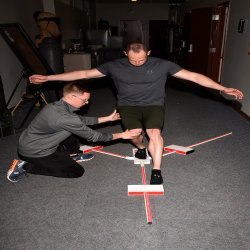Two of the key factors that influence balance and knee valgus may be the dorsiflexion ROM of the ankle and the internal rotation ROM of the hip.
A new study examined 121 members of the military and assessed the degree of knee valgus during a single-leg squat. The researchers found that subjects with limited ankle dorsiflexion or hip internal rotation demonstrated significantly higher degrees of knee valgus during the single-leg squat.
Additionally, the researchers also assessed balance using a Y-Balance Test. In the anterior direction, increased ankle dorsiflexion was correlated with improved balance. Interestingly, in both the posterolateral and posteromedial directions, the only factor that was correlated with improved balance was increased trunk extensor endurance.
Conclusions
This study supports the ”joint-by-joint approach” and shows that when ankle or hip mobility are limited, compensatory movement can occur at nearby joints such as the knee. The study highlights the importance for maintaining proper joint mobility in order to preserve healthy knee mechanics and improve balance.
References
